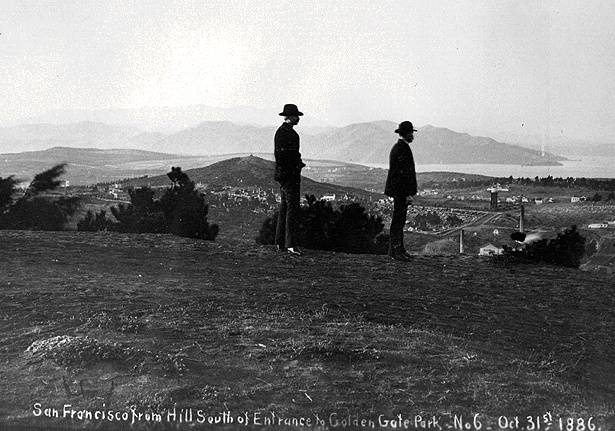Buena Vista Peak: Difference between revisions
m (1 revision(s)) |
(Changed credits from Greg Garr to Private Collection) |
||
| (6 intermediate revisions by one other user not shown) | |||
| Line 1: | Line 1: | ||
'''<font face = Papyrus> <font color = maroon> <font size = 4>Historical Essay</font></font> </font>''' | |||
''by Pete Holloran'' | |||
[[Image:hashbury$buena-vista-view-1886.jpg]] | [[Image:hashbury$buena-vista-view-1886.jpg]] | ||
'''Buena Vista Park in 1886. Without planted trees blocking the view, you can see a cemetery at the foot of Lone Mountain, as well as a huge sand dune behind Lone Mountain.''' | '''Buena Vista Park in 1886. Without planted trees blocking the view, you can see a cemetery at the foot of Lone Mountain, as well as a huge sand dune behind Lone Mountain.''' | ||
The great sand dunes that once covered a third of San Francisco climbed up and over this hilltop park. Hundreds of years ago, as pioneering vegetation stabilized the active dunes, the soils became rich enough to support coast live oaks. San Francisco's largest remnant stands of coast live oak woodlands occur on the northern slopes of Buena Vista Park, in the northeast section of Golden Gate Park, and along Lobos Creek in the Presidio. | ''Photo: Private Collection, San Francisco, CA'' | ||
The great sand dunes that once covered a third of San Francisco climbed up and over this hilltop park. Hundreds of years ago, as pioneering vegetation stabilized the active dunes, the soils became rich enough to support coast live oaks. San Francisco's largest remnant stands of [[Coast Live Oaks (Quercus agrifolia)|coast live oak woodlands]] occur on the northern slopes of Buena Vista Park, in the northeast section of Golden Gate Park, and along [[Dune restoration|Lobos Creek]] in the Presidio. | |||
The Natural Areas Program of the San Francisco Recreation and Park Department is restoring the parks oak woodland by removing ivy and other exotic plants, controlling erosion, and planting native plants. Monthly work parties are led by park staff working with the Friends of Buena Vista Park. | The Natural Areas Program of the San Francisco Recreation and Park Department is restoring the parks oak woodland by removing ivy and other exotic plants, controlling erosion, and planting native plants. Monthly work parties are led by park staff working with the Friends of Buena Vista Park. | ||
[[Image:Tours-habitat.gif|link=Why is it called "Richmond"?]] [[Why is it called "Richmond"?|-->Open Space Habitat tour continues]] | |||
[[Buena Vista History | Prev. Document]] [[Downtown vista 1955 | Next Document]] | |||
[[ | [[category:Haight-Ashbury]] [[category:1880s]] [[category:habitat]] | ||
Latest revision as of 15:21, 16 June 2014
Historical Essay
by Pete Holloran
Buena Vista Park in 1886. Without planted trees blocking the view, you can see a cemetery at the foot of Lone Mountain, as well as a huge sand dune behind Lone Mountain.
Photo: Private Collection, San Francisco, CA
The great sand dunes that once covered a third of San Francisco climbed up and over this hilltop park. Hundreds of years ago, as pioneering vegetation stabilized the active dunes, the soils became rich enough to support coast live oaks. San Francisco's largest remnant stands of coast live oak woodlands occur on the northern slopes of Buena Vista Park, in the northeast section of Golden Gate Park, and along Lobos Creek in the Presidio.
The Natural Areas Program of the San Francisco Recreation and Park Department is restoring the parks oak woodland by removing ivy and other exotic plants, controlling erosion, and planting native plants. Monthly work parties are led by park staff working with the Friends of Buena Vista Park.

